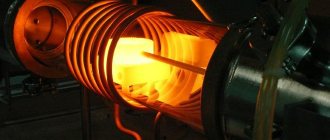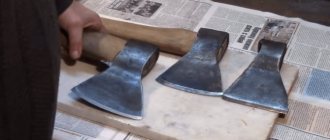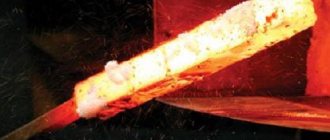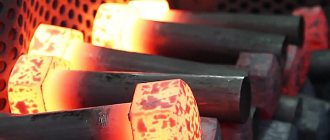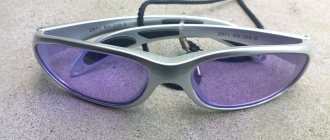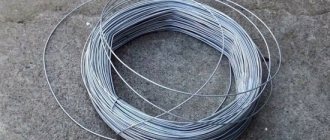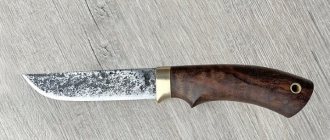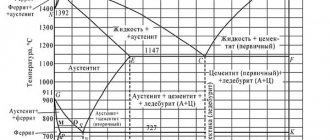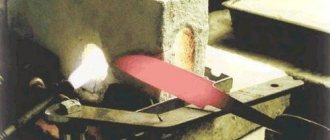Chemical composition
The 65G spring steel grade is a combination of the following ingredients:
- carbon (C) – 0.65-0.7%;
- silicon (Si) – 0.17-0.37%;
- manganese (Mn) – 0.9-1.2%;
- nickel (Ni) and chromium (Cr) – with a limit of 0.25%;
- sulfur (S) and phosphorus (P) – no more than 0.035%;
- copper (Cu) – up to 0.2%;
- iron (Fe) – 97%.
Chemical composition of grade 65G
The main task of the products made is to maintain maximum durability and elasticity. This effect can be achieved by adding 1% manganese. The remaining components are classified as impurities and are added in accordance with government standards.
Common parameters
The substances included in this material and its further heat treatment provide:
- high wear resistance;
- good impact strength;
- tensile strength;
- high resistance to impact.
The absence of a large number of alloying elements allows for a relatively low price of this steel.
To obtain the specified parameters, 65G steel is hardened at a temperature of 800 to 830 ºC. Tempering is carried out at a temperature of 160 to 200 ºC; this tempering is called high. Cooling is performed in air. Such heat treatment modes make it possible to obtain a product with a surface hardness of 45-47 HRC.
The technologist, when designing the heat treatment process, must remember that 65G steel and its analogues are not afraid of overheating, but when hardening is performed at the upper points of the temperature range, the impact strength may decrease.
Temperature selection
For the correct completion of the hardening process, the correct selection of temperature, which depends on the material used, is very important.
Steels based on carbon content are divided into hypoeutectoid - less than 0.8% and hypereutectoid - more than 0.8%. Steel with carbon less than 0.4% is not hardened due to the resulting low hardness. Hypoeutectoid steels are heated slightly above the temperature of the phase transformation of pearlite and ferrite to austenite. This occurs in the range of 800-850°C. Then the workpiece is quickly cooled. When cooled sharply, austenite transforms into martensite, which has high hardness and strength. A short holding time makes it possible to obtain fine-grained austenite and fine-needle martensite; the grains do not have time to grow and remain small. This steel structure has high hardness and at the same time low brittleness.
Microstructure of steel
Hypereutectoid steels are heated slightly lower than hypoeutectoid steels, to a temperature of 750-800°C, that is, incomplete hardening is performed. This is due to the fact that when heated to this temperature, in addition to the formation of austenite, a small amount of cementite, which has a higher hardness than martensite, remains undissolved in the metal melt. After rapid cooling, austenite transforms into martensite, and cementite remains in the form of small inclusions. Also in this zone, carbon that has not had time to completely dissolve forms solid carbides.
In the transition zone during high-frequency quenching, the temperature is close to the transition temperature, and austenite with ferrite residues is formed. But, since the transition zone does not cool down as quickly as the surface, but cools down slowly, as during normalization. At the same time, the structure in this zone improves, it becomes fine-grained and uniform.
After cooling, high compressive stresses remain on the metal surface, which increase the performance properties of the part. Internal stresses between the surface layer and the middle must be eliminated. This is done using low-temperature tempering - holding at a temperature of about 200°C in an oven. To avoid the appearance of microcracks on the surface, it is necessary to minimize the time between hardening and tempering.
You can also carry out the so-called self-tempering - cool the part not completely, but to a temperature of 200 ° C, while heat will remain in its core. Then the part should cool slowly. This will equalize internal stresses.
https://youtube.com/watch?v=vUaDCaVcjac
Heating the metal
All steel hardening methods consist of:
- heating steel;
- subsequent holding to achieve through-heating of the product and completion of structural transformations;
- cooling at a certain speed.
Carbon steel products are heated in chamber furnaces. In this case, preheating is not required, since these steel grades are not subject to cracking or warping.
https://youtube.com/watch?v=I-br0B8ocpI
Complex products (for example, a tool with protruding thin edges or sharp transitions) are preheated:
- in salt baths by immersing two or three times for 2 - 4 seconds;
- in separate ovens up to a temperature of 400 - 500 degrees Celsius.
Heating of all parts of the product should proceed evenly. If this cannot be achieved in one step (large forgings), then two holding times are made for through heating.
If only one part is placed in the oven, the heating time is reduced. For example, one 24 mm thick disk cutter heats up within 13 minutes, and ten such products heat up within 18 minutes.
Methods for preventing scale formation and critically reducing carbon concentrations
The purpose of steel hardening is carried out taking into account what qualities the part should have. The process of rebuilding the atomic grid is associated with high risks of the appearance of various defects, which is taken into account at the stage of development of the technological process.
Even the most common methods, for example, quenching steel in water, are characterized by the appearance of scale or a significant increase in the fragility of the structure with a decrease in carbon concentration. In some cases, steel hardening is carried out after finishing, which does not allow even minor defects to be eliminated. This is why technologies have been developed that reduce the likelihood of scale or cracks. An example is a technology where steel is hardened in a protective gas environment. However, complex methods of steel hardening significantly increase the cost of the procedure, since the gas environment is achieved when installing furnaces with a high degree of tightness.
A simpler technology, in which carbon steel is hardened, involves the use of cast iron shavings or used carburizer. In this case, the steel for hardening is placed in a container filled with the materials in question, after which only heating is carried out. The hardening temperature is slightly adjusted taking into account the created shell of chips. The technology involves coating the outside of the container with clay in order to prevent the ingress of oxygen, which begins the oxidation process.
Heating temperature of steel during heat treatment
As previously noted, heat treatment also involves cooling steels, for which not only a water bath, but, for example, a salt bath can be used. When using acids as a coolant, one of the requirements is periodic deoxidation of steels. This process eliminates the possibility of a decrease in the carbon concentration in the surface layer. To carry out the deoxidation process, boric acid or charcoal is used. Also, do not forget that the process of deoxidation of steels leads to the appearance of flames on the workpiece while it is lowered into the bath. Therefore, when hardening or hardening steels using salt baths, the developed safety precautions should be observed.
Considering these methods of heat treatment with subsequent cooling, it should be noted that they significantly increase the cost of the workpiece. However, today cooling in water or quenching while filling the chamber with oxygen does not allow increasing the properties of steel without the appearance of defects.
Steel hardening - technological process
Characteristics and properties
Having in its chemical composition 0.75...0.85% carbon, as well as a small amount of other elements - silicon, manganese, chromium, nickel and copper - U8 steel is ectectoid. With reduced manganese and silicon contents, the critical cooling rate always increases. Therefore, in practice, U8 steel is used only for the manufacture of metalworking tools with small overall dimensions. Hardening of steel of this type allows the use of very harsh cooling media (water or aqueous solutions of salts). Thus, this steel is not hardenable: the core remains viscous, and the hardness obtained as a result of preliminary annealing of the workpieces remains almost the same.
Scheme of structural transformations of U8
Quenching in water also has other negative consequences - with an increase in the cooling rate, the structure of the steel remains coarse-grained. During further processing (for example, forging), this feature can cause cracking of the forging, especially at significant degrees of deformation. Often, when quenched in water, the product loses its dimensions and warps, which forces additional calibration of the tool.
The temperature of the critical points of U8 steel is:
- The beginning of the austenitic transformation from the initial pearlite when heated is 720 °C.
- The end of the austenitic transformation is 740 °C.
- The temperatures at which the transformation of austenite into pearlite begins and ends upon cooling coincide and are within 700 °C.
- The martensitic transformation, starting at 810 °C, ends at 245 °C.
Hardness of steel after heat treatment
Steel 20Х13 - chromium stainless steel - Foundries of Russia
Classification of chromium stainless steelsSteel 08Х13Steel 12Х13Steel 30Х13
Steel 40Х13
Application of steel 20Х13
Steel 20Х13 is used in the manufacture of products for work in mildly aggressive environments:
- atmospheric conditions other than sea;
- aqueous solutions of salts of organic acids at room temperature;
- solutions of nitric acid of weak and medium concentrations at moderate temperatures, etc.
Steel 20X13 is used in cases where products must have sufficiently high strength, as well as high ductility and toughness. 20X13 steel can be welded satisfactorily.
Steel 20X13 is also used as a heat-resistant material at temperatures up to 450-550 °C and as a heat-resistant material - up to 700 °C.
Chemical composition of steel 20Х13
Steel 20Х13 is included in steel type Х13 along with steels 08Х13, 12Х13, 30Х13 and 40Х13. It occupies its own range in carbon content - from 0.16 to 0.25%, the amounts of other alloying elements and impurities are the same as in other steels of the X13 type (Table 1).
Table 1 - Chemical composition of steel 20Х13 according to GOST 5632-72
Steel class 20Х13 according to GOST 5632-72
According to the GOST 5632-72 classification, steel 20Х13 belongs to the martensitic class.
Transformations and microstructure of steel 20Х13
- When annealed steel 20Х13 is heated, the polymorphic alpha-gamma transformation occurs in it in the temperature range from 820 °C (Ac1) to 950 °C (Ac3). The temperature of point Ar1 is 780 °C.
- During isothermal holding or slow cooling in the range of 800-550 °C, austenite decomposes into a ferrite-carbide mixture.
This ferrite-carbide mixture consists of high chromium ferrite and Cr23C6 type carbide. - When 20Х13 steel is rapidly cooled, a martensitic transformation occurs in it. The temperature at which the martensitic transformation begins is 220 °C.
- With an increase in tempering temperature, there is a significant decrease in strength with an increase in ductility, as well as a decrease in corrosion resistance.
Steel range 20Х13
The following products are produced from steel 08Х13:
- thick sheet according to GOST 7350-77;
- thin sheet according to GOST 5582-75;
- tape and roll according to GOST 4986-78;
- long products according to GOST 5949-75;
- hot-deformed pipes according to GOST 9940-81;
- cold-deformed and heat-deformed pipes according to GOST 9941-81;
- wire according to GOST 18143-72.
Mechanical properties of steel 20Х13
The mechanical properties of steel 20Х13 in various types of products are presented in Table 2.
Table 2 - Mechanical properties of steel 20Х13 at 20 °С
The effect of decreasing and increasing temperature on the mechanical properties of a rod made of steel 20X13 after normalization from 1000-1020 °C and tempering at 730-750 °C is shown in Table 3.
Table 3 - Mechanical properties of steel 20Х13 at low and elevated temperatures
Corrosion resistance of steel 20Х13
Steel 20Х13 is highly resistant to atmospheric conditions (except for the sea atmosphere), river and tap water.
Special properties of steel 20Х13
For parts operating at elevated temperatures for a long time, the maximum operating temperature is 450-475 °C, for short-term operation - 500-550 °C.
The density of steel 20Х13 is 7.76 g/cm3.
Heat treatment of welds of steel 20Х13
After welding, tempering of welded joints or products is carried out. The tempering temperature depends on the level of mechanical properties required. Tempering at 680-760 °C is most often used.
Technological parameters of steel 20Х13
Steel 20Х13 has good processability during hot plastic deformation. The temperature range of hot plastic deformation ranges from 1100 to 875-950 °C. Heating for rolling and forging to 780 °C is carried out slowly. After hot deformation, slow cooling is used.
For steel 20Х13, softening annealing is usually used at 750-800 °C with cooling in a furnace to 500 °C. Final heat treatment - hardening from 950-1000 °C with cooling in oil or air and tempering to a given hardness and corrosion resistance.
Subsequent release technology
As already indicated, to obtain the sorbitol structure, products made from 65G steel are subjected only to high tempering at temperatures of 550...600 °C, with cooling in still air. For particularly critical parts, an additional low holiday is sometimes carried out. Its temperature range is 160...200 °C, followed by slow cooling in air. This technology avoids the accumulation of thermal stresses in the product and increases its durability. For tempering, you can use not only flame, but also electric furnaces equipped with devices for forced air circulation. The holding time of products in such furnaces is from 110 to 160 minutes (increased time standards correspond to parts with complex configurations and large cross sections).
It is not recommended to use water and aqueous solutions of salts as working media when hardening 65G steel. The acceleration of the cooling process caused by water is often accompanied by uneven calcination.
The final quality control of hardening consists of assessing the macro- and microstructure of the metal, as well as determining the final hardness of the product. The surface hardness of products made from 65G steel should be within 35...40 HRC after normalization, and 40...45 HRC after quenching with high tempering.
40ХН2МА steel properties
σ4551/10000=686 MPa, σ4551/1000=137 MPa, σ5901/10000=13 MPa, σ5901/1000=29 MPa.
| Mechanical properties of steel 40ХН2МА | ||||||||||
| GOST | Delivery condition, heat treatment mode | Section, mm | KP | σ0.2 (MPa) | σв(MPa) | δ5 (%) | ψ % | KCU (J/cm2) | NV, no more | |
| GOST 4543-71 | Bar. Hardening 850 °C, oil. Vacation 620 °C, water | 25 | — | 930 | 1080 | 12 | 50 | 78 | — | |
| Bar. Hardening 850 °C, oil. Temperature 620 °C, oil. | 25 | — | 835 | 980 | 12 | 55 | 98 | — | ||
| GOST 8479-70 | Forgings. Hardening. Vacation | 500-800 | 440 | 440 | 635 | 11 | 30 | 39 | 197-235 | |
| 300-500 500-800 | 490 | 490 | 655 | 12 11 | 35 30 | 49 39 | 212-248 | |||
| 100-300 300-500 | 540 | 540 | 685 | 13 12 | 40 35 | 49 44 | 223-362 | |||
| 100-300 300-500 500-800 | 590 | 590 | 735 | 13 12 10 | 40 35 30 | 49 44 39 | 235-277 | |||
| 100-300 300-500 | 640 | 640 | 785 | 12 11 | 38 33 | 49 44 | 248-293 | |||
| 100-300 | 685 | 685 | 835 | 12 | 38 | 49 | 262-311 | |||
| Up to 100 100-300 | 735 | 735 | 880 | 13 12 | 40 35 | 59 49 | 277-321 | |||
| Up to 100 100-300 | 785 | 785 | 930 | 12 11 | 40 35 | 59 49 | 293-331 | |||
| Mechanical properties of steel 40ХН2МА depending on tempering temperature | ||||||||||
| Temperature, °C | σ0.2 (MPa) | σв(MPa) | δ5 (%) | ψ % | KCU (J/cm2) | HB | ||||
| Hardening 850 °C, oil | ||||||||||
| 200 300 400 500 600 | 1600 1470 1240 1080 860 | 1750 1600 1370 1170 960 | 10 10 12 15 20 | 50 50 52 59 62 | 59 49 59 88 147 | 525 475 420 350 275 | ||||
| Mechanical properties of steel 40ХН2МА at elevated temperatures | ||||||||||
| Test temperature, °C | σ0.2 (MPa) | σв(MPa) | δ5 (%) | ψ % | KCU (J/cm2) | |||||
| Hardening 850 °C, oil. Vacation 580 °C. | ||||||||||
| 20 250 400 500 | 950 830 770 680 | 1070 1010 950 700 | 16 13 17 18 | 58 47 63 80 | 78 109 84 54 | |||||
| Sample 5 mm in diameter, 25 mm long, rolled. Deformation speed 2 mm/min. Strain rate 0.001 1/s | ||||||||||
| 700 800 900 100 1100 1200 | — — — — — — | 185 89 50 35 24 14 | 17 66 69 75 72 62 | 32 90 90 90 90 90 | — — — — — — | |||||
| Endurance limit of steel 40ХН2МА | ||||||||||
| σ-1, MPA | J-1, MÏÀ | n | Heat treatment | |||||||
| 447 392 519 | 274 235 | 106 | Section 100 mm. Hardening 850 °C, oil. Vacation 580 °C, σв=880 MPa. Section 400 mm. Hardening 850 °C, oil. Temperature 610 °C, σв=790 MPa, σ0.2=880 MPa, σв=1080 MPa | |||||||
| Impact strength of steel 40ХН2МА KCU , (J/cm2) | ||||||||||
| Т= +20 °С | Т= -40 °С | Т= -60 °С | Heat treatment | |||||||
| 103 | 93 | 59 | Hardening 860 °C, oil. Vacation 580 °C | |||||||
| Mechanical properties of steel 40ХН2МА depending on the section | ||||||||||
| Section, mm | Sample cutting location | σ0.2 (MPa) | σв(MPa) | δ4 (%) | ψ % | KCU (J/cm2) | HRCE | |||
| Bar. Hardening 850 °C, oil. Vacation 620 °C | ||||||||||
| 40 60 80 100 120 | Central Central 1/2R 1/2R 1/3R | 880 830 730 670 630 | 1030 980 880 850 830 | 14 16 17 19 20 | 57 60 61 61 62 | 118 127 127 127 127 | 33 32 29 26 25 | |||
| Hardening 850 °C, oil. Vacation 540-660 °C | ||||||||||
| up to 16 16-40 40-100 100-160 160-250 | Ts ts ts ts | 1000 900 800 700 650 | 1200-1400 1100-1300 1000-1200 900-1100 850-1000 | 9 10 11 12 12 | — — — — — | 90 50 60 60 60 | — — — — — | |||
| Hardenability of steel 40ХН2МА | ||||||||||
| Distance from the end, mm | Note | |||||||||
| 1,5 | 3 | 6 | 9 | 12 | 15 | 21 | 27 | 33 | 42 | Hardening 840 °C |
| 49-59,5 | 40,5-60 | 50-60 | 50-59,5 | 49-59 | 48-59 | 45-56 | 41,5-53 | 41-50,5 | 36,5-48,5 | Hardness for hardenability strips, HRC |
| Amount of martensite, % | Critical hardness, HRCе | Critical diameter in water | Critical diameter in oil | |||||||
| 50 90 | 44-47 49-53 | 153 137-150 | 114 100-114 | |||||||
| Physical properties of steel 40ХН2МА | ||||||||||
| T (Grad) | E 10-5 (MPa) | a 10 6 (1/Deg) | l (W/(m deg)) | r (kg/m3) | C (J/(kg deg)) | R 10 9 (Ohm m) | ||||
| 20 | 2.15 | 39 | 7850 | 331 | ||||||
| 100 | 2.11 | 11.6 | 38 | 490 | ||||||
| 200 | 2.01 | 12.1 | 37 | 506 | ||||||
| 300 | 1.9 | 12.7 | 37 | 522 | ||||||
| 400 | 1.77 | 13.2 | 35 | 536 | ||||||
| 500 | 1.73 | 13.6 | 33 | 565 | ||||||
| 600 | 13.9 | 31 | ||||||||
| 700 | 29 | |||||||||
| 800 | 27 | |||||||||
| Brief designations: | ||||||||||
| σв | — temporary tensile strength (tensile strength), MPa | å | — relative settlement at the appearance of the first crack, % | |||||||
| σ0.05 | — elastic limit, MPa | Jê | — ultimate torsional strength, maximum shear stress, MPa | |||||||
| σ0.2 | — conditional yield strength, MPa | σben | — ultimate bending strength, MPa | |||||||
| δ5,δ4,δ10 | — relative elongation after rupture, % | σ-1 | — endurance limit during bending test with a symmetrical loading cycle, MPa | |||||||
| σсж0.05 and σсж | — compressive yield strength, MPa | J-1 | — endurance limit during torsion testing with a symmetrical loading cycle, MPa | |||||||
| ν | — relative shift, % | n | — number of loading cycles | |||||||
| sв | — short-term strength limit, MPa | R and ρ | — electrical resistivity, Ohm m | |||||||
| ψ | — relative narrowing, % | E | — normal modulus of elasticity, GPa | |||||||
| KCU and KCV | — impact strength, determined on a sample with concentrators of the types U and V, respectively, J/cm2 | T | — temperature at which properties were obtained, degrees | |||||||
| sT | — proportionality limit (yield strength for permanent deformation), MPa | l and ë | — thermal conductivity coefficient (heat capacity of the material), W/(m °C) | |||||||
| HB | — Brinell hardness | C | - specific heat capacity of the material (range 20o - T), [J/(kg deg)] | |||||||
| H.V. | — Vickers hardness | pn and r | — density kg/m3 | |||||||
| HRСе | — Rockwell hardness, scale C | A | — coefficient of thermal (linear) expansion (range 20o - T), 1/°С | |||||||
| HRB | — Rockwell hardness, scale B | σtТ | — long-term strength limit, MPa | |||||||
| HSD | - Shore hardness | G | — modulus of elasticity during torsional shear, GPa |
xn--402-8cd3de9c.xn--p1ai
Spring steel 65G - characteristics, hardness, explanation
There are types of steels that have limited use. These include spring steel 65G. Its characteristics are distinguished by high elasticity parameters and wear resistance.
knives made of steel 65G
The photo shows a throwing knife “Twist” with an all-metal blade made of 65G steel
: Steel 5ХНМ - explanation, characteristics, GOST
Alloy composition
Minor additives include:
- chromium, which increases the hardness of the material, the degree of its heat resistance is 0.25%;
- nickel, which imparts anti-corrosion properties and ductility - up to 0.25%;
- copper, increasing corrosion resistance – 0.20%;
- sulfur and phosphorus – 0.035% each.
The last two elements refer to harmful impurities, the presence of which is inevitable. Phosphorus reduces the ductility of the alloy and increases its brittleness. Sulfur causes the phenomenon of red brittleness, that is, the appearance of cracks in the metal during intense heating. However, their concentration in the alloy does not exceed the value permissible for a high-quality material.
A small amount of alloying additives ensures that the alloy is relatively cheap, which makes it extremely popular. The chemical composition determines the physical and technological properties of 65G steel:
- hardness at 20°C – 285 HB;
- elastic modulus – 84 GPa;
- high tensile strength – 750 MPa;
- good impact strength – 3.0 – 3.5 kg*m/cm2;
- specific gravity – 7850 kg/m3;
- temperature range for hardening – 800 – 830°C;
- forging temperature range – 760 – 1250°C.
Substitutes for the alloy can be the following brands:
- 55С2;
- 60С2А;
- 9ХС;
- 50HFA;
- 60С2;
- 70G;
- 55C.
Among the foreign analogues we can note:
- G15660 - in the United States;
- 66Mn4 – Germany;
- 65Mn – China;
- 080A67 - Great Britain.
Heat treatment
Steel 65G, the characteristics of which are initially determined by its chemical composition, is subject to further heat treatment. In many ways, the quality of the products produced depends on it. As a result of thermal effects:
- internal structural changes occur in the metal;
- its mechanical properties are improved;
- the wear resistance of products increases;
- their reliability increases;
- the cost of parts is reduced due to the use of cheaper additives;
- The scope of product use is expanding.
The main stages of heat treatment are the following processes:
- annealing;
- further normalization;
- hardening and tempering.
Hardening and tempering of products
Hardening occurs when a part is heated to temperatures above critical, and quickly cooled in a certain environment. The temperature range suitable for hardening parts made of 65G steel is 800 – 820°C. Further cooling is carried out in oil, which eliminates the possibility of cracking the surface of the products.
Depending on the characteristics specified by the operational requirements for products, when selecting a hardening mode, the following are taken into account:
- heating equipment and method;
- process temperature range;
- exposure time in the selected mode;
- type of quenching medium;
- method of further cooling.
Annealing of products is carried out by reheating, after which holding and slow cooling procedures are carried out. The annealing temperature corresponds to the thermal effect during hardening of steel.
Tempering of the metal is carried out to eliminate internal stresses that appeared in it during the hardening process. At the output, the hardness of the alloy decreases somewhat, but its viscosity increases.
Tempering is carried out by secondary heating at a lower temperature and subsequent quiet cooling.
In addition, by changing the tempering temperature conditions, it is possible to impart different mechanical properties to the metal.
For products made from 65g steel, a high tempering option is usually carried out in the temperature range of 550 - 600 degrees with further cooling in air, but this reduces the impact strength.
For products requiring high reliability and durability, low tempering in the range of 160 - 200 ° C is additionally used, accompanied by slow cooling in air.
The output hardness of the steel can be 45 – 47 HRC.
Advantages and disadvantages
Undoubtedly, the wide range of applications is due to the obvious advantages that 65G steel has:
- characteristics and use for knives are determined by resistance to impact deformation and ease of sharpening;
- high hardness, up to 50-55 HRC, protects products from breakage;
- low cost makes it possible to reduce the cost of manufactured products;
- high tensile strength makes it indispensable in the manufacture of spring products;
- a significant yield strength allows the product to restore its shape after the deforming load ceases;
- metal lends itself well to forging;
- After the blackening procedure, an oxide film is formed on its surface, protecting the surface from corrosion.
Like any alloy, 65G steel has certain disadvantages:
- it is highly susceptible to corrosion;
- despite easy sharpening, finishing the cutting edge is too labor-intensive;
- there is a possibility of deformation under shock loads.
Application area
The alloy is a structural material with a high degree of elasticity, which allows it to be used in mechanical engineering and machine tool manufacturing for the production of mechanisms operating under long-term loads:
- for creating springs in cars;
- thrust washers and slates;
- bearings and brake bands;
- spring mechanisms;
- friction discs.
The following can also be made from steel grades 65 and 70:
- sports blades;
- throwing knives;
- medical products;
- razors;
- other elements not subject to prolonged shock loads.
The material is not suitable for welding and use in conditions of high humidity, as it is susceptible to corrosion. However, it can be used in resistance spot welding operations. Products made from it must be lubricated with oil or used only in a dry room.
Description of steel grade 65g
65 is the carbon content in the alloys in hundredths, and “g” is manganese (the alloying element).
Steel forging temperature: start - 1250 °C, end - 760−780°C.
65 g is a wear-resistant, tough, durable, elastic material with good tear resistance and shock resistance.
Mechanical properties of steel - the following categories:
- 3;
- 3a;
- 3b;
- 3c;
- 3 g;
- 4;
- 4a;
- 4b.
Quenching temperature - 830 °C, oil. Temperature: 470°C.
There are several types of supply of 65 g steel, one of them is the following:
General information about steel 65g
This steel is very popular due to its relatively low cost . It belongs to the spring-spring type and passes the bluing and blackening procedures very well.
Due to its characteristics, it is used to make throwing knives; it is extremely rarely used to create cutting knives.
This is due to the fact that such steel oxidizes extremely quickly and becomes rusty.
If we talk about hardening, then this material is not afraid of overheating. However, if the temperatures are high enough, the toughness decreases quite quickly, which in turn inevitably leads to large grain growth in the fine texture of the fibers.
The hardening temperature can be different (from 800 to 820 degrees Celsius). It all depends on the complexity of the outline of the original product and the metal characteristics required for a particular use scenario.
Due to the addition of Manganese, such an alloy is also called deoxidized steel; this applies to absolutely all materials containing such a component. Knives acquire their properties in cases where pearlite transformation has been achieved during the hardening process.
Chemical composition in % of material 65G
| C | Si | Mn | Ni | S | P | Cr | Cu |
| 0.62 — 0.7 | 0.17 — 0.37 | 0.9 — 1.2 | up to 0.25 | up to 0.035 | up to 0.035 | up to 0.25 | up to 0.2 |
Mechanical properties:
| sв | — Short-term strength limit, |
| sT | — Limit of proportionality (yield strength for permanent deformation), |
| d5 | — Elongation at break, |
| y | — Relative narrowing, |
| KCU | — Impact strength, |
| HB | — Brinell hardness, |
Physical properties:
| T | — Temperature at which these properties were obtained, |
| E | — Modulus of elasticity of the first kind, |
| a | — Coefficient of thermal (linear) expansion (range 20° - T), |
| l | — Thermal conductivity coefficient (heat capacity of the material), |
| r | — Density of the material, |
| C | — Specific heat capacity of the material (range 20° - T ), |
| R | — Electrical resistivity, |
Magnetic properties:
| Hc | — Coercive force (no more), |
| Umax | — Magnetic permeability (no more), |
| P1.0/50 | — Specific losses (no more) at magnetic induction 1.0 T and frequency 50 Hz, |
| B100 | — Magnetic induction Tl (not less) in magnetic fields at a magnetic field strength of 100, |
Weldability:
| no limits | — welding is performed without heating and without subsequent heat treatment |
| limited weldability | — welding is possible when heated to 100-120 degrees. and subsequent heat treatment |
| difficult to weld | — to obtain high-quality welded joints, additional operations are required: heating to 200-300 degrees. during welding, heat treatment after welding |
Characteristics of steel (briefly)
- Wear resistance
- Viscosity
- Strength
- Elasticity
- Tear resistance
- Impact resistance
- The knives show a good cut (although this is of no use for throwing knives)
- Relatively low cost
Technological properties of material 65G
| Weldability: | not applicable for welded structures |
| Flock Sensitivity: | insensitive |
| Tendency to temper brittleness: | inclined |
Steel for tournament weapons
All of the above is relevant not only for the manufacture of throwing knives, but also for the production of tournament weapons (swords, checkers, etc.).
In the photo: Tournament weapons for the “Heroic Fun” festival in the Oruzheynik park (Zlatoust) were made from 65G steel.
: Steel 65X13 for knives - characteristics, application
Peculiarities
Due to its properties, 65g steel is not suitable for welding. But it is worth noting that the range of uses is quite wide, even if you do not take into account edged weapons. Various springs, springs, bearing housings, components and metal structures are made from it. It has found application even in trucks - this particular material is used to create rear axle springs.
In order for the material to retain its properties and not become rusty, it must be kept in a dry room, and the products must be periodically coated with oil.
Due to its low cost and fairly decent properties, 65g steel is used as analogues of such materials as: 55С2, 60С2, 70, 70Г, У8А, 9Хс.
The elasticity of the metal during forging allows you to make edged weapons and blades at home. It is for this reason that 65g steel has become widespread in this industry. This applies to manual production not only of sports equipment or tools for reconstruction, but also for domestic use - in the kitchen.
Minuses
As noted above, steel belongs to the carbon group and is susceptible to corrosion. Therefore, do not forget two important rules: keep the blades dry and clean and periodically lubricate them with castor oil. Caring for knives made from 65G steel is comparable to caring for knives made from Damascus steel.
Heat treatment modes
The temperature range for hardening steel 65G is in the range of 800-830 °C. Subsequent high tempering at 160-200 °C with further cooling in still air makes it possible to obtain a steel hardness of 45-47 HRC. This grade of steel is not afraid of overheating, however, when hardened at high temperatures, the impact strength of the steel begins to decrease.
Throwing knife "Luch-B"
Made of 65G steel with braid Manufactured by the company “AiR”, Zlatoust, Russia The knife is made of 65G steel, ...
price 1694 rub.
Throwing knife "Viking"
Made of 65G steel with braid Manufactured by the company “AiR”, Zlatoust, Russia The knife is made of 65G steel, ...
price 1694 rub.
Throwing knife "Katran"
Made of 65G steel with braid Manufactured by the company “AiR”, Zlatoust, Russia The knife is made of 65G steel, ...
price 1694 rub.
Throwing knife "Luch-S"
Made of 65G steel with braid Manufactured by the company “AiR”, Zlatoust, Russia The knife is made of 65G steel, ...
price 1694 rub.
Throwing knife "Twist"
Made of 65G steel with braid Manufactured by the company “AiR”, Zlatoust, Russia The knife is made of 65G steel, ...
price 1694 rub.
price 5352 rub.
| Share on social networks: |
Steel hardening technology 45
To harden 45 steel means to subject it to heating to the required temperature, holding for a certain time and cooling. There are some nuances here. Metal heating is carried out in two ways:
- in special electric furnaces of continuous or periodic operation;
- high frequency currents (HFC).
These methods differ in technology, namely quenching temperature, holding time and cooling medium.
When heated in a furnace, the heating temperature does not exceed 860 °C, usually 45 steel is heated at a rate of no more than 3 °C per second above 790 °C, and in a HDTV device it can reach up to 920 °C at a rate of 250 °C per second, respectively.
It is these modes that make it possible to change the atomic lattice of iron. As a result of heating (the temperature should be higher than the dissolution of ferrite in austenite) and holding, it will become face-centered from body-centered. In order for the structure to level out in the metal, it is kept in a furnace or in an installation for some time.
This depends on the thickness of the workpiece. Only after this is it cooled. At this time, the reverse process occurs, which ultimately gives the surface strength and hardness.
Cooling is carried out in special environments to a temperature of 20÷25 °C. The working medium can be water, mineral oils or a mixture of water with salts or caustic soda.
The temperature of the working medium ranges from 20÷60 °C and is indicated in the technological process of hardening steel 45. Modes are set depending on the composition of the hardening medium. In this case, after heating, the part can be lowered into a container with a working medium or cooled by spraying.
After heating, 45 steel is most often cooled in water or oil, and the oil cools evenly, which prevents cracks from occurring. Then the workpiece or part is subjected to low-temperature tempering, which helps to equalize thermal stresses.
This makes it possible to obtain a working surface hardness of 50 HRC, which is more than enough for most parts operating under heavy loads.
Hardening modes of steel 65G
To comply with the characteristics specified by the technical conditions for the operation of parts, when choosing a hardening mode, the following components are taken into account:
- method and equipment for heating products to the required temperatures;
- establishing the required hardening temperature range;
- choosing the optimal holding time at a given temperature;
- selection of the type of quenching medium;
- technology for cooling the part after hardening.
The intensity of heating determines the quality of the resulting structure. For low-alloy steels, the process is carried out quite quickly, since this minimizes the risk of decarburization of the material, and, as a consequence, the loss of the part’s strength parameters. However, too rapid heating causes other problems. In particular, for large parts with large differences in cross sections, this can cause uneven heating of the metal, with the prospect of further appearance of hardening cracks, chipping of corners and edges.
Temperature of the workpiece depending on the color when heated
To achieve the maximum degree of heating uniformity, the steel is first heated in the preliminary chambers of thermal furnaces to temperatures slightly lower than hardening temperatures - from 550 to 700 ° C, and only then the part is sent directly to the hardening furnace. Heating occurs fastest in molten salts, slower in gas furnaces, and even slower in electric furnaces. That is why surface hardening of 65G steel products in induction furnaces is performed quite rarely. The inductor, as a hardening unit, is used only for products with a small cross section. When choosing the type of heating device, the composition of the atmosphere that is created in it is also important. In particular, for thermal furnaces operating on gas, they try in every possible way to reduce the duration of the part’s stay in the furnace, since otherwise some of the carbon in the surface layer will burn out.
Based on the quenching temperature normalized for 65G steel at 800...820 °C, the maximum value of the decarbonized layer should not be more than 50...60 µm.
The temperature range of quenching temperatures can be adjusted depending on the product configuration. For example, if the part has complex shapes, small dimensions and is made of sheet metal, then the optimal temperature will be the lower limit of the above range. By controlling the hardening temperature (for example, using automatic temperature sensors), you can change the thickness of the hardened layer and the size of the zone that is less hardened than others. Such technical solutions are resorted to when different parts of a part operate under different operating conditions.
Steel 65G is not afraid of overheating, however, when hardening at the upper value of the temperature range, the impact strength of the material begins to decrease, which is accompanied by the growth of grains in the microstructure.
To reduce warping of parts that have thin ribs and bridges, they are heated in salt quenching baths. More often, a melt of sodium chloride is used, and for deoxidation, borax or ferrosilicon is added to the working volume of the bath.
When hardening products made from steel 65G, holding at a given temperature range occurs until the pearlite transformation completely occurs.
This process depends on the cross-sectional size of the part and the heating method. For the most common cases, you can use the table data: Heating and holding times depending on the quenching medium and dimensions of the workpiece
| Largest overall dimension of the part, mm | Hardening in a fiery furnace | Hardening in an electric furnace | ||
| Heating time, min | Holding time, min | Heating time, min | Holding time, min | |
| Up to 50 | 40 | 10 | 50 | 10 |
| Up to 100 | 80 | 20 | 88 | 20 |
| Up to 150 | 120 | 30 | 130 | 30 |
| Up to 200 | 160 | 40 | 175 | 40 |
Cooling of products after hardening is carried out not in water, but in oil, this avoids the possible danger of cracking.
Manufacturing a chamber for hardening metal
The main materials for the manufacture of home furnace bodies for steel hardening are solid refractories in the form of blocks of various sizes and fireclay clay. In such a furnace, a temperature of over 1200 °C is reached, so it is possible to harden products not only from carbon or tool steel, but also from high-alloy steel. When making home stoves from fireclay clay, a cardboard frame is first made according to the shape and size of the working chamber, which is then covered with a layer of fireclay. A heating coil is wound over it, and then the main heat-insulating layer is applied.
With this design, the heating area is isolated from the heating element, which is important when it is necessary to harden steel that is sensitive to oxides and carbon burnout. The most common design of home hardening furnaces are installations whose thermal bodies are made of fireclay bricks or similar refractories
The operating temperature of such materials is more than 1400 °C, so in such furnaces it is possible to harden almost any type of steel and many refractory alloys. Structurally, such a home oven is similar to a conventional wood-burning oven, only it is much smaller in size. The metal in it is heated using an electric spiral placed in grooves along the perimeter of the internal space. If it is necessary to qualitatively harden steel, it must be heated to a precisely specified temperature, so most of these homemade products are equipped with thermostats (they can be freely purchased on Aliexpress).
The video below shows the design of such a home furnace with end loading and a thermostat, which allows you to harden steel with precise temperature conditions. Its thermal body is made of mullite-silica refractory plates ShPT-450.
A detailed description of the design and recommendations for creating a top-loading furnace, in which you can harden products up to 54 cm in length, can be seen in the following video. Here the thermal body of the furnace is made of fireclay bricks (ShB type) and a thermostat is also used. In addition to the top loading, a special feature of this device is a kanthal spiral, which lasts many times longer than traditional nichrome and fechral.
How to harden metal at home
There are a large number of methods, involving various techniques and other devices. However, in this article we will look at the two most popular ones, which are best suited for home use: in a stove or oven and over a fire.
There is no fundamental difference between these methods. The main thing is to place the knife or other product in the oven or fire and monitor its temperature.
The first step is annealing, that is, the main step of heat treatment.
It is important to monitor the temperature of the steel and prevent overheating. If there is no special device that can be used to measure its current indicator, you can evaluate it by the color of the heat:
- Orange - from 950 to 1000 degrees;
- Red-orange - from 900 to 950;
- Red - from 800 to 900;
- Darkish red - from 750 to 800 degrees;
- Red-burgundy - from 700 to 750;
- Burgundy - from 650 to 700;
- Brown-red - from 550 to 650;
- Reddish brown - 500 to 550 degrees.
You can also check the readiness of hardening using a regular magnet. If it stops “sticking” to the metal, then its temperature is about 760 degrees, and it is necessary to proceed to cooling as quickly as possible.
For a more convenient holiday, you can also check the color of the product, thus:
- Gray - 350 degrees;
- Blue - 300−350 degrees;
- Blue - 300 degrees;
- Purple - 280 degrees;
- Red-brown - 260 degrees;
- Yellow-brown - 250 degrees;
- Straw yellow - 240 degrees;
- Light yellow - 200−240 degrees.
So, as you can see, it is quite easy to harden a steel product at home. However, you should always remember safety precautions and also keep in mind the instructions described in this article.
Cooling methods during hardening
Methods of cooling metal during water and oil quenching are widely used in industry. The most ancient composition for hardening swords and other thin-walled objects is saline solution. Hardening was carried out by blacksmiths using forging heat and the heat generated by deformation.
Red sabers, swords, knives were dipped into the urine of red-haired guys. In Europe they were simply stuck into the bodies of living slaves. The colloidal composition containing salts and acids made it possible to cool the steel at an optimal speed and not create unnecessary stresses and leads.
Currently, various sodium salt solutions, saltpeter and even plastic shavings are used.
how to harden steel 45 Video
6 months back
The 45 dies were hardened using water and tempered at low temperatures. If you need to harden...
2 years ago
There are several ways to distinguish 45 steel from regular steel. The two simplest ones are to remove shavings from the product...
2 years ago
3 years ago
1 year ago
2 years ago
In this video I show one of the ways I harden and temper metal, I show the hardening of a chisel.
8 months back
1 year ago
Planing on a homemade turntable.
4 years ago
Old educational film on heat treatment of steel. It is useful for beginning blacksmiths.
1 year ago
2 years ago
Hardening of a cylindrical punch for punching a hole with a diameter of 7.2 mm.
1 year ago
In this video I show what will happen to the metal if it is cooled in the wrong liquid during hardening. I will show it bursting...
1 year ago
8 years ago
This is interesting: Hardening of steel - temperature, modes, technology, hardness of steel after hardening
Optimal technological processes for heat treatment of materials
The choice of heat treatment mode is dictated by production requirements. In most cases, to impart proper physical and mechanical characteristics, the following is used:
- normalization;
- hardening followed by tempering.
The temperature-time parameters of heat treatment and the choice of its type depend on the initial structure of the steel. This material belongs to the hypoeutectoid type steels, therefore, at temperatures above the lower point of the austenitic transformation - 723 ° C - by 30...50 ° C it contains austenite in the form of a solid mechanical mixture with a small amount of ferrite. Since austenite is a harder structural component than ferrite, the quenching temperature range for 65G steel will be significantly lower than for structural steels with a lower percentage of carbon. Thus, the temperature range for hardening steel of this grade should be within the range of no more than 800...830 °C.
Approximately the same temperature range is used to carry out normalization - a technological heat treatment operation, which is used to correct the structure of the material of the product, to relieve internal stresses, and during subsequent mechanical processing of the semi-finished product - to improve its workability.
Since the impact strength of hardened steel 65G is reduced, after hardening, products made from it, in particular springs, must undergo a high tempering. The martensitic-austenitic transformations that occur during tempering reduce the level of internal stresses arising during hardening, reduce brittleness and slightly increase impact toughness.
The transition to high tempering is excluded from the mode only when the workpiece undergoes isothermal hardening. As a result of high tempering, 65G steel acquires a sorbitol structure, the characteristic features of which are the fine dispersion of the structure while maintaining initially high hardness values, which fully meets the operational requirements.
Heat treatment of steel 65G
Structural high-carbon steel grade 65G, supplied in accordance with the technical requirements of GOST 14959, is a steel of the spring group. It must combine high surface hardness (for which up to 1% manganese is added to its composition) and increased elasticity. All these characteristics are ensured as a result of proper heat treatment of products made from the steel in question.
HDTV hardening
Initial chemical composition of steel and requirements for parts made from it
Belonging to the category of sparingly alloyed steel, 65G steel is relatively cheap, which makes it widely and effectively used. Among its main components are:
- carbon (within 0.62...0.70%);
- manganese (within 0.9…1.2%);
- chromium and nickel (up to 0.25...0.30%).
All other components are copper, phosphorus, sulfur, etc. – refer to impurities, and are allowed in the chemical composition of this material in quantities limited by the state standard.
Spring steels
With sufficient hardness (for example, after surface normalization it should be at least 285 HB) and tensile strength (not lower than 750 MPa), 65G steel has a fairly high impact strength for its class - 3.0...3.5 kg∙m /cm2. This makes it possible to use the material for the production of critical parts of lifting and transport equipment (in particular, running wheels of overhead cranes, rollers), as well as spring washers and springs for non-critical purposes.
It is worth noting that spring parts made of 65G steel are poorly welded and cannot withstand periodically occurring tensile stresses (relative elongation does not exceed 9%), and therefore cannot be used in one-piece structures of machines and mechanisms. When carrying out cold plastic deformation processes, steel becomes very low-plasticity even at small (up to 10%) deformations, therefore, if it is necessary to manufacture large-sized springs from it, it is necessary to use heating of the original blanks, even for sheet stamping. However, even in the hot state, the maximum degree of deformation of 65G steel does not exceed 50...60%.
Chemical composition of steel 65G
Despite the fact that during strain hardening the ultimate tensile strength of the material increases to 1200...1300 MPa, these indicators are not enough to give the final product (for example, springs) the necessary operational strength. Therefore, quenching and tempering of 65G steel is mandatory.
Spring knife
A knife is a great thing that can be useful not only as an excellent tool, but also as a wonderful souvenir. Every boy will be happy with such a gift. If a knife is made by hand, it immediately becomes a unique value in the eyes of the owner.
Adults also do not always use knives exclusively for household purposes - many people collect them. Everyone’s selection criteria are different, but everyone knows that high-quality steel is a prerequisite for a good knife. But a beautifully crafted handle can make no less an impression than a durable blade that can hold an edge for a long time.
The use of spring steel for making a knife
Spring material 65G is used by amateur knife makers to make knives. Thanks to its unique characteristics, the metal finds its application in various fields.
Blades for the kitchen, hunting, tourism - all show excellent cutting qualities. If there is a special need, you can actually forge a sword or an ax. After hardening, the steel acquires good rigidity, which allows the product to be cut.
Examples of using spring steel:
- Kitchen knife. In difficult times for the country, after the collapse of the USSR, not all people could afford a good set of kitchen knives. I had to get out. Springs and plates made of 65G steel were easily accessible. In the kitchens of the post-Soviet space, homemade products were often found. The handle was made from improvised material: wood, simple epoxy, and electrical tape - which did not prevent the knives from remaining at their height.
- Tourist knife. The disadvantage of spring metal is that it is susceptible to corrosion and requires constant care after use. The knife is suitable for use in hiking conditions. An important point is hardening. If it is weak, the blade will quickly become dull on the tin can. You should know the hardness of the knife.
- Army. Tactical or, nowadays, military knives do their job well. Serrated sharpening will increase the scope of use of the blade. Withstands piercing blows without problems. In everyday conditions it will become a valuable assistant for a fighter or a “survivalist”.
- Axe, machete or sword. Alloy 65G and analogs allow you to make truly formidable weapons. The thickness of the product certainly plays a significant role. When producing such a masterpiece, you need to stock up on springs from a truck, or get a long plate.
With proper processing of the metal, we are guaranteed to get an excellent blade. Little experience with the manufacture of steel products is nonsense. Further, in the article we will provide a detailed description of the manufacture of knives from springs using various methods.
What is steel normalization and a description of this process
Often, for production purposes, it becomes necessary to change the parameters of steel; one of the ways to do this is heat treatment. By their principle, most heat treatment technologies involve changing the structure of steels through heating, holding and cooling.
Despite the fact that all these technologies have the same goals and operating principles, they all differ in temperature and time conditions. Heat treatment can be either an intermediate or a final process during production. In the first case, the material is prepared for subsequent processing, and in the second, new properties are given to it.
One such technology is steel normalization. This is the name for heat treatment, in which the material is heated to a temperature 30-50 degrees above Ast or Ac3, and then it is cooled in still air.
Principles of normalization
Like other heat treatment technologies, normalization can be either an intermediate or a final operation to improve the structure of steel. Most often it is used in the first case; as a final procedure, normalization is mainly used in the production of long products such as rails, channels and more.
The key feature of normalization is that the steel is heated to a temperature that is 30-50 degrees higher than the upper critical values, and the material is also held and cooled.
This or that temperature is selected depending on the type of material. Hypereutectoid materials are normalized at a temperature between points Ac 1 and Ac 3, but hypoeutectoid materials are normalized at temperatures above Ac 3. As a result, materials of the first type obtain the same hardness, since carbon passes into the solution in the same amount, and austenite is also fixed in the same amount. The structure includes cement and martensite.
Thanks to this composition, the wear resistance and hardness of the hypereutectoid material increases. If high-carbon steel heats up above Ac 3, the growth of austenite grains will increase and, accordingly, internal stresses will increase. The carbon concentration will also increase, and as a result, the martensitic transformation temperature will decrease. As a result, the material becomes less durable and hard and can be changed.
And hypoeutectoid steel, when heated above a critical value, becomes very viscous. This is explained by the fact that fine-grained austenite is formed in low-carbon steel. This component, after cooling, transforms into fine-crystalline martensite. Temperature values in the interval between Ac 1 and Ac 3 cannot be used for processing, since in this case the structure of hypoeutectoid steel receives ferrite, which reduces its hardness after normalization, and after tempering, its mechanical properties.
The holding time depends on the degree of homogenization of the material structure. The standard indicator is an hour of exposure per 25 mm of thickness. The intensity of cooling to one degree or another determines the size of the plates and the amount of perlite.
Technological nuances of hardening
Hardening, which is a type of heat treatment of metals, is performed in two stages. First, the metal is heated to a high temperature and then cooled. Different metals and even steels belonging to different categories differ from each other in their structure, therefore their heat treatment modes do not coincide.
Heat treatment modes for some non-ferrous alloys
Heat treatment of metal (hardening, tempering, etc.) may be required for:
- its strengthening and increasing hardness;
- improving its ductility, which is necessary when processing by plastic deformation.
Many specialized companies harden steel, but the cost of these services is quite high and depends on the weight of the part that needs to be heat treated. That is why it is advisable to do this yourself, especially since you can do it even at home.
If you decide to harden the metal on your own, it is very important to correctly carry out such a procedure as heating. This process should not be accompanied by the appearance of black or blue spots on the surface of the product. The bright red color of the metal indicates that heating is occurring correctly. This video demonstrates this process well, which will help you get an idea of the degree to which to heat the metal subjected to heat treatment.
As a heat source for heating the metal product that needs to be hardened to the required temperature, you can use:
- a special oven powered by electricity;
- blowtorch;
- an open fire that you can make in the yard of your house or in your country house.
Hardening a knife on open coals
The choice of heat source depends on the temperature to which the metal to be heat treated must be heated.
The choice of cooling method depends not only on the material, but also on the results to be achieved. If, for example, it is not necessary to harden the entire product, but only a separate section of it, then cooling is also carried out pointwise, for which a stream of cold water can be used.
The technological scheme by which metal is hardened may include instant, gradual or multi-stage cooling.
Rapid cooling, which uses one type of coolant, is optimal for hardening steels classified as carbon or alloy. To perform such cooling, you need one container, which can be a bucket, barrel, or even an ordinary bathtub (it all depends on the size of the item being processed).
Cooling the knife blank in oil
In the event that steels of other categories need to be hardened or if, in addition to hardening, tempering is required, a two-stage cooling scheme is used. With this scheme, a product heated to the required temperature is first cooled with water and then placed in mineral or synthetic oil, in which further cooling occurs. Under no circumstances should an oil-based cooling medium be used directly, as the oil may ignite.
In order to correctly select the hardening modes of various steel grades, you should focus on special tables.
Heat treatment modes for high-speed steels
Heat treatment modes for alloy tool steels
Heat treatment modes for carbon tool steels
